Dear Umbra,
We heat our house primarily by wood, in an efficient, EPA-rated woodstove. My question is this: We recycle all of our paper, paperboard, cardboard, etc., but would it be better to burn it? As it is, we drive it to the recycle center, they ship it off somewhere, it is then processed, then shipped back out as a product. If we burn it, we get some heat, and ashes to spread on our garden. Which is better for paper — recycling or burning?
Joan
Bremen, Maine
Dearest Joan,
Recycling wins, I’m afraid. I answered a similar question last year, about burning trash in the back yard instead of paying to have it removed. The answer there was no. Our little backyard fires are in fact terrible emitters compared to modern incinerators, and many of the reasons for not burning trash in the proverbial “burn barrel” also apply to your woodstove. Paper is filled with materials waiting to become toxic motes upon the updraft of your chimney, dioxin the most familiar among them.

A little goes a long way.
Photo: iStockphoto
A bit of newspaper is necessary for starting a good fire, but beyond that we must recycle as we can in our neighborhoods. I am relaying the party line from every Department of Ecology I came across: Only burn the amount of newspaper necessary to start a fire. All other paper counts as garbage. In particular, we are not to burn glossy paper, colored paper, or cardboard.
I think the general idea is that regular old wood is bad enough. Your stove, and other EPA-certified efficient woodstoves with catalytic converters and fabulous tuning controls, has been designed and calibrated to deal with well-cured wood. The stove tries to minimize the particulates and compounds inherent to wood combustion. It has less of an ability to manage paper. Paper, despite what we learned in Richard Scarry’s What Do People Do All Day?, contains more than just wood. There are inks, adhesives, and shiny coatings. A paper recycling plant has processes for managing all these paper additives, and then, of course, it reuses the wood fibers at the heart of the paper. Your stove has no method for managing all the paper additives; they just go up your chimney and the wood fibers at the heart of the paper give off a smidgen of heat before they, too, transform into harmful particulates and gases. Recycling-plant water, which is filled with the removed additives, is treated before release into the general environment. Although treatment may not be perfect, it is certainly better than the lack of treatment in our home chimney.
Recycled paper production also uses much less energy than virgin paper production — 30 to 70 percent less — so you can feel good about providing a feedstock for the recycled paper project. The energy benefit of recycling is even so large as to neutralize the impacts of trucking the old paper hither and yon. It sounds impossible, but appears to be true. We are fortunate to live in a time when some industrial processes are cleaner than our home processes. Paper recycling is such a process. We must embrace it and turn aside from the tempting maw of the stove.
Draftily,
Umbra

